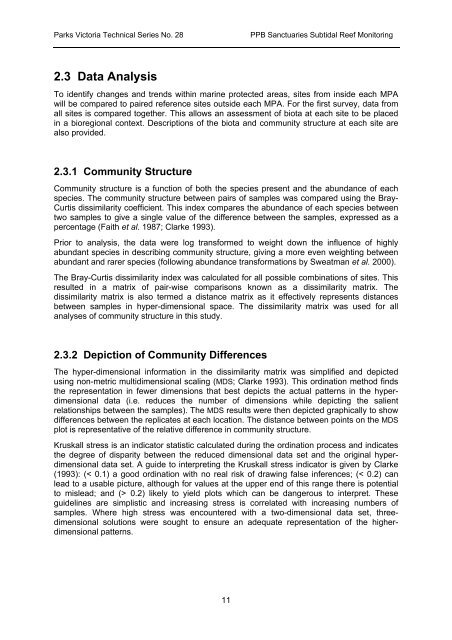Victorian Subtidal Reef Monitoring Program - Parks Victoria
Victorian Subtidal Reef Monitoring Program - Parks Victoria
Victorian Subtidal Reef Monitoring Program - Parks Victoria
You also want an ePaper? Increase the reach of your titles
YUMPU automatically turns print PDFs into web optimized ePapers that Google loves.
<strong>Parks</strong> <strong>Victoria</strong> Technical Series No. 28PPB Sanctuaries <strong>Subtidal</strong> <strong>Reef</strong> <strong>Monitoring</strong>2.3 Data AnalysisTo identify changes and trends within marine protected areas, sites from inside each MPAwill be compared to paired reference sites outside each MPA. For the first survey, data fromall sites is compared together. This allows an assessment of biota at each site to be placedin a bioregional context. Descriptions of the biota and community structure at each site arealso provided.2.3.1 Community StructureCommunity structure is a function of both the species present and the abundance of eachspecies. The community structure between pairs of samples was compared using the Bray-Curtis dissimilarity coefficient. This index compares the abundance of each species betweentwo samples to give a single value of the difference between the samples, expressed as apercentage (Faith et al. 1987; Clarke 1993).Prior to analysis, the data were log transformed to weight down the influence of highlyabundant species in describing community structure, giving a more even weighting betweenabundant and rarer species (following abundance transformations by Sweatman et al. 2000).The Bray-Curtis dissimilarity index was calculated for all possible combinations of sites. Thisresulted in a matrix of pair-wise comparisons known as a dissimilarity matrix. Thedissimilarity matrix is also termed a distance matrix as it effectively represents distancesbetween samples in hyper-dimensional space. The dissimilarity matrix was used for allanalyses of community structure in this study.2.3.2 Depiction of Community DifferencesThe hyper-dimensional information in the dissimilarity matrix was simplified and depictedusing non-metric multidimensional scaling (MDS; Clarke 1993). This ordination method findsthe representation in fewer dimensions that best depicts the actual patterns in the hyperdimensionaldata (i.e. reduces the number of dimensions while depicting the salientrelationships between the samples). The MDS results were then depicted graphically to showdifferences between the replicates at each location. The distance between points on the MDSplot is representative of the relative difference in community structure.Kruskall stress is an indicator statistic calculated during the ordination process and indicatesthe degree of disparity between the reduced dimensional data set and the original hyperdimensionaldata set. A guide to interpreting the Kruskall stress indicator is given by Clarke(1993): (< 0.1) a good ordination with no real risk of drawing false inferences; (< 0.2) canlead to a usable picture, although for values at the upper end of this range there is potentialto mislead; and (> 0.2) likely to yield plots which can be dangerous to interpret. Theseguidelines are simplistic and increasing stress is correlated with increasing numbers ofsamples. Where high stress was encountered with a two-dimensional data set, threedimensionalsolutions were sought to ensure an adequate representation of the higherdimensionalpatterns.11
















